Business Plan: Healthy and Tasty - Food Service in Colombo, Sri Lanka
VerifiedAdded on 2023/06/05
|13
|2997
|436
AI Summary
This business plan assesses the feasibility of "Healthy and Tasty," a food service start-up in Colombo, Sri Lanka. It highlights the company's core competencies in human resources, information systems, and financial resources, and it employs PESTLE, SWOT, and Porter’s Five Forces analyses to evaluate the macro and micro environmental factors. The plan emphasizes the importance of human resource planning and deployment strategies for building business competence. It identifies potential challenges, such as competitive supplier negotiations, and formulates strategies for market entry and growth. The plan also considers the political, economic, social, technological, legal, and environmental factors influencing the business, along with competitive rivalry, threats of substitutes and new entrants, and bargaining power of suppliers and buyers.
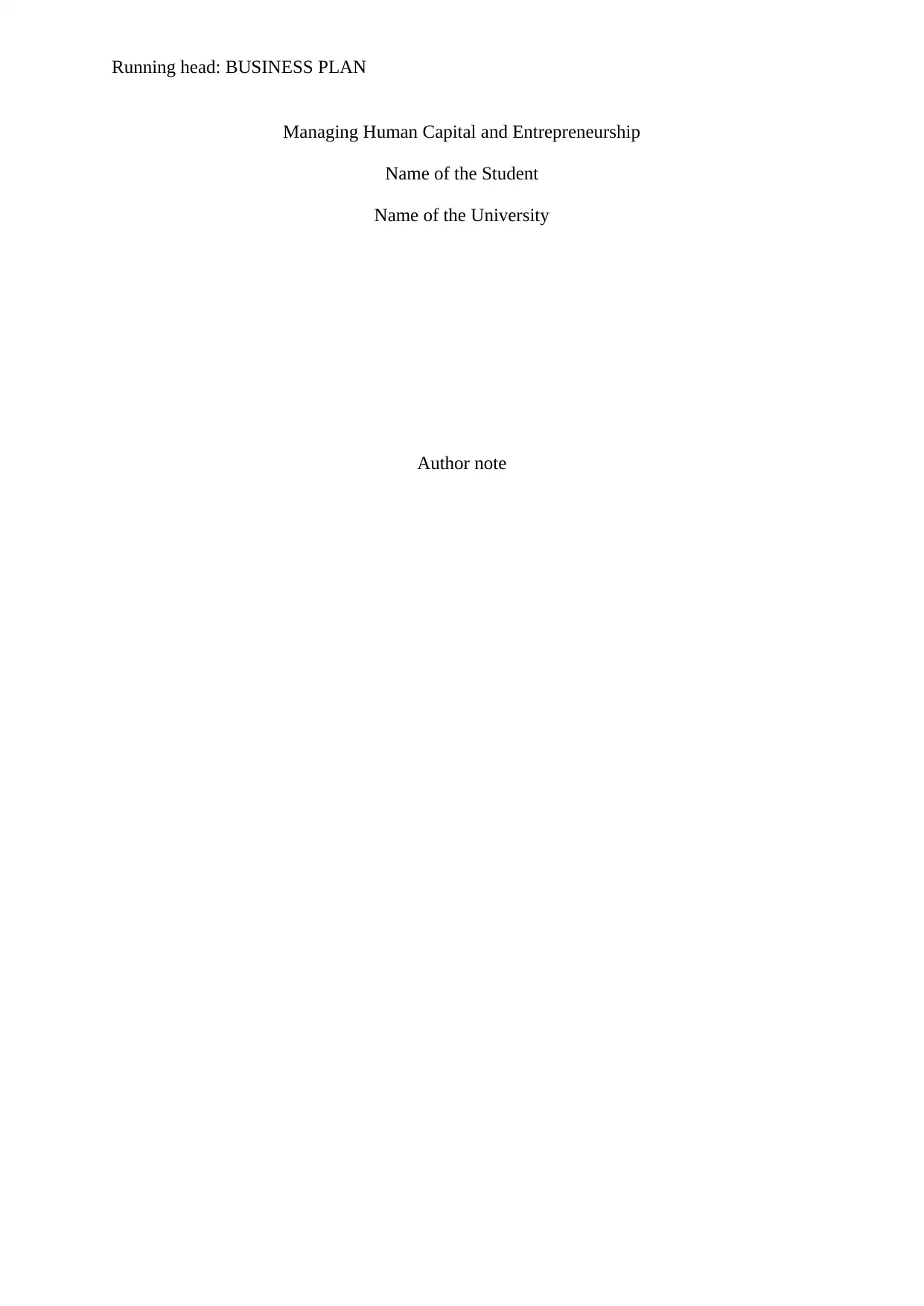
Running head: BUSINESS PLAN
Managing Human Capital and Entrepreneurship
Name of the Student
Name of the University
Author note
Managing Human Capital and Entrepreneurship
Name of the Student
Name of the University
Author note
Paraphrase This Document
Need a fresh take? Get an instant paraphrase of this document with our AI Paraphraser
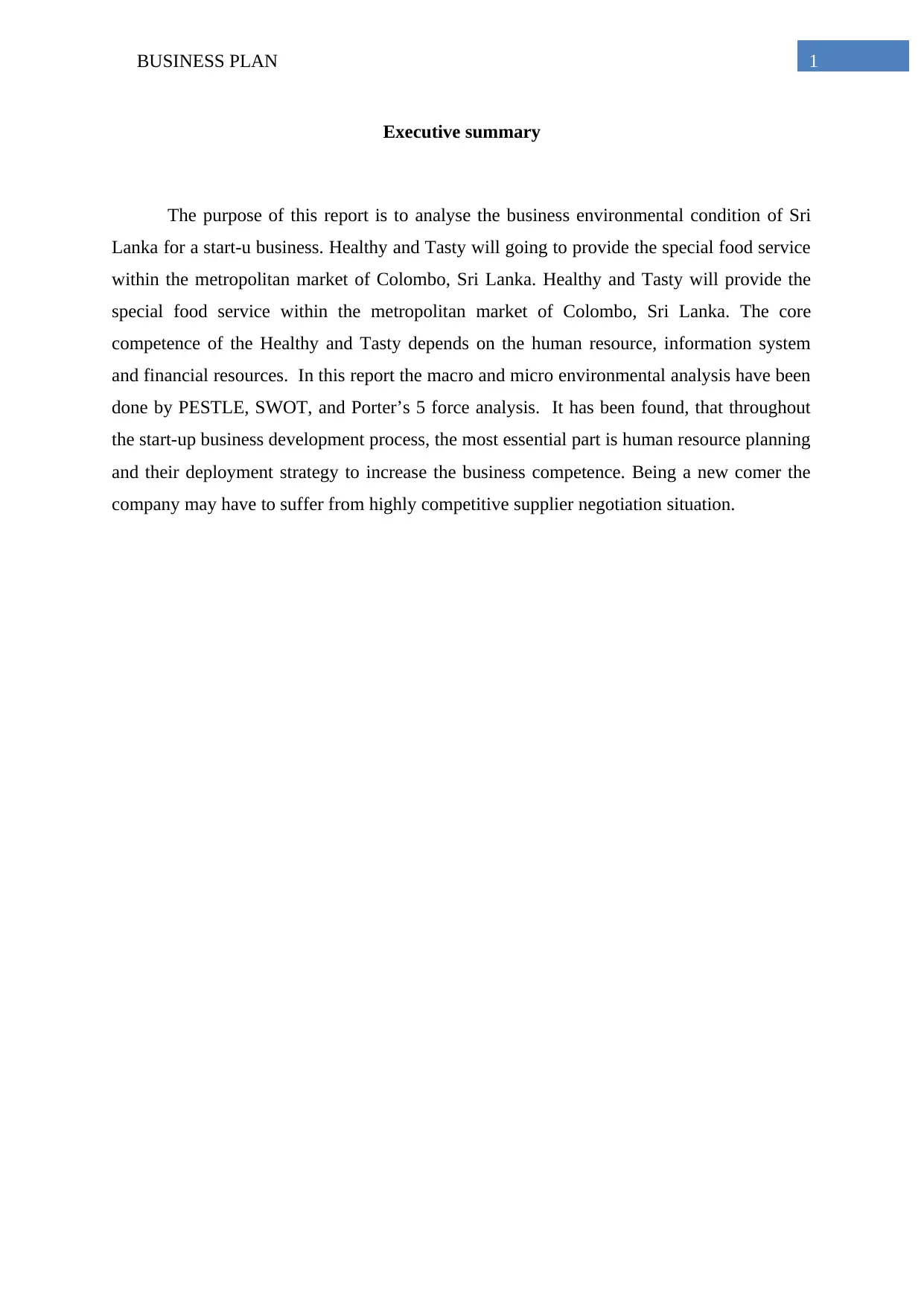
1BUSINESS PLAN
Executive summary
The purpose of this report is to analyse the business environmental condition of Sri
Lanka for a start-u business. Healthy and Tasty will going to provide the special food service
within the metropolitan market of Colombo, Sri Lanka. Healthy and Tasty will provide the
special food service within the metropolitan market of Colombo, Sri Lanka. The core
competence of the Healthy and Tasty depends on the human resource, information system
and financial resources. In this report the macro and micro environmental analysis have been
done by PESTLE, SWOT, and Porter’s 5 force analysis. It has been found, that throughout
the start-up business development process, the most essential part is human resource planning
and their deployment strategy to increase the business competence. Being a new comer the
company may have to suffer from highly competitive supplier negotiation situation.
Executive summary
The purpose of this report is to analyse the business environmental condition of Sri
Lanka for a start-u business. Healthy and Tasty will going to provide the special food service
within the metropolitan market of Colombo, Sri Lanka. Healthy and Tasty will provide the
special food service within the metropolitan market of Colombo, Sri Lanka. The core
competence of the Healthy and Tasty depends on the human resource, information system
and financial resources. In this report the macro and micro environmental analysis have been
done by PESTLE, SWOT, and Porter’s 5 force analysis. It has been found, that throughout
the start-up business development process, the most essential part is human resource planning
and their deployment strategy to increase the business competence. Being a new comer the
company may have to suffer from highly competitive supplier negotiation situation.
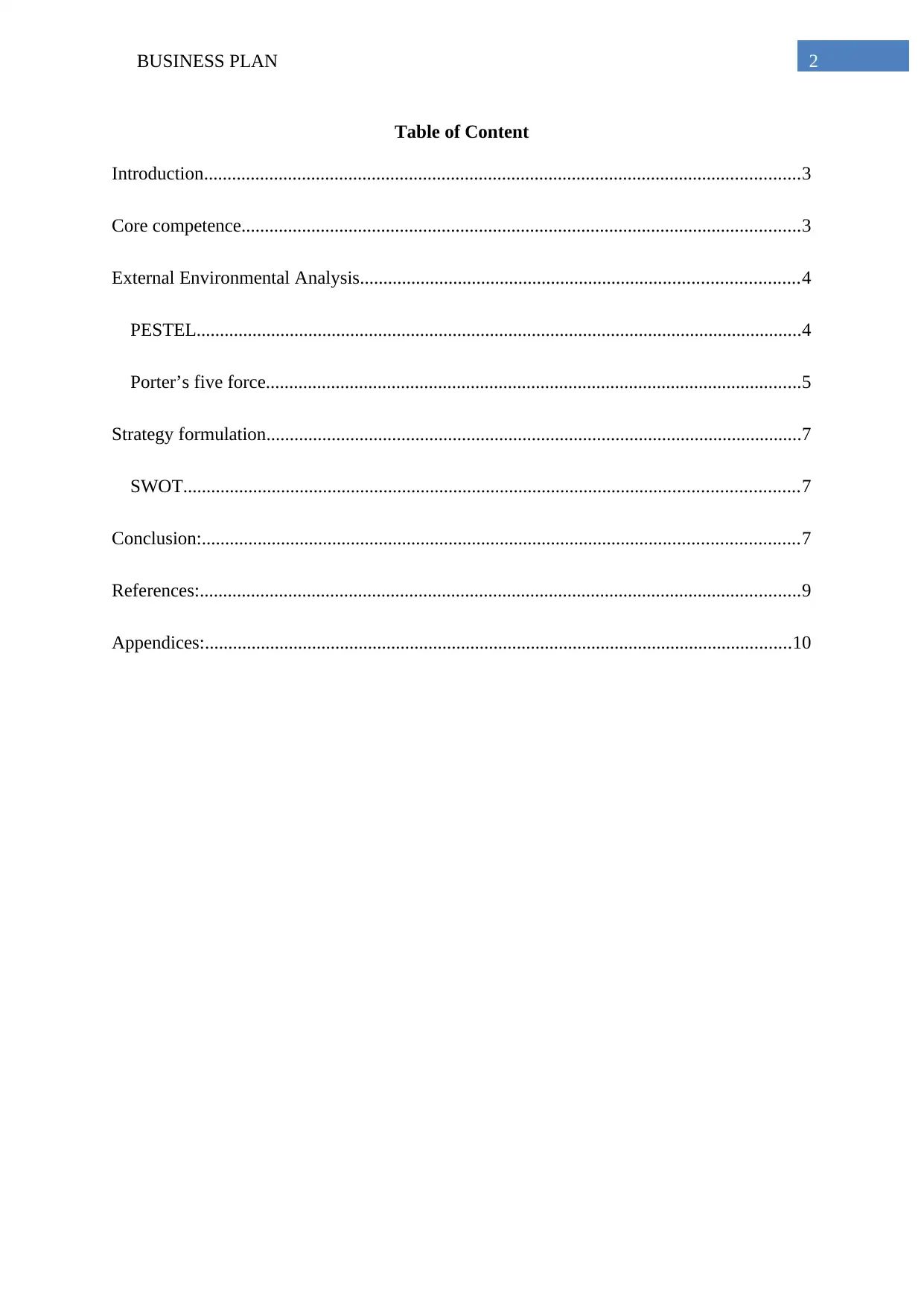
2BUSINESS PLAN
Table of Content
Introduction................................................................................................................................3
Core competence........................................................................................................................3
External Environmental Analysis..............................................................................................4
PESTEL..................................................................................................................................4
Porter’s five force...................................................................................................................5
Strategy formulation...................................................................................................................7
SWOT....................................................................................................................................7
Conclusion:................................................................................................................................7
References:.................................................................................................................................9
Appendices:..............................................................................................................................10
Table of Content
Introduction................................................................................................................................3
Core competence........................................................................................................................3
External Environmental Analysis..............................................................................................4
PESTEL..................................................................................................................................4
Porter’s five force...................................................................................................................5
Strategy formulation...................................................................................................................7
SWOT....................................................................................................................................7
Conclusion:................................................................................................................................7
References:.................................................................................................................................9
Appendices:..............................................................................................................................10
⊘ This is a preview!⊘
Do you want full access?
Subscribe today to unlock all pages.

Trusted by 1+ million students worldwide
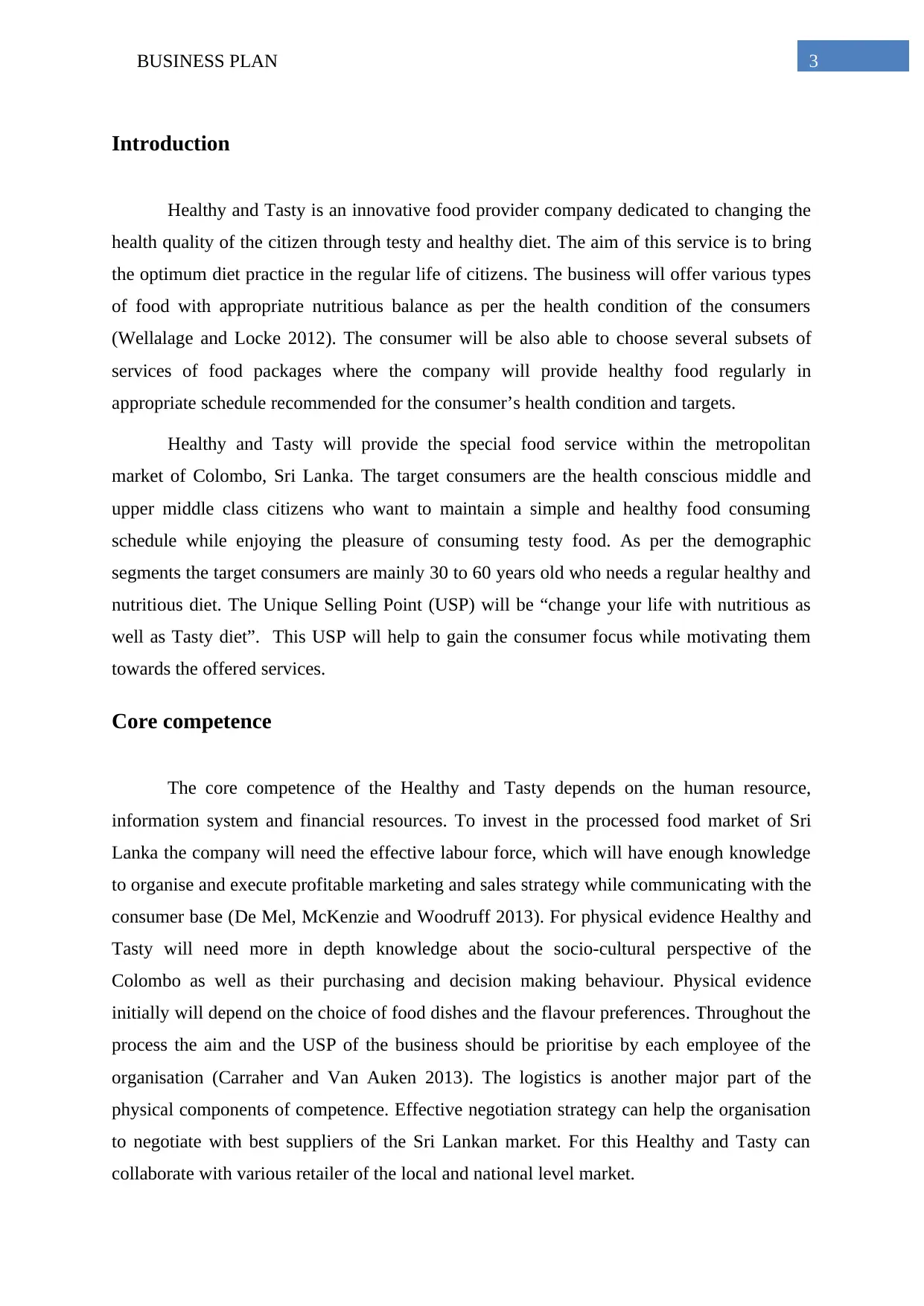
3BUSINESS PLAN
Introduction
Healthy and Tasty is an innovative food provider company dedicated to changing the
health quality of the citizen through testy and healthy diet. The aim of this service is to bring
the optimum diet practice in the regular life of citizens. The business will offer various types
of food with appropriate nutritious balance as per the health condition of the consumers
(Wellalage and Locke 2012). The consumer will be also able to choose several subsets of
services of food packages where the company will provide healthy food regularly in
appropriate schedule recommended for the consumer’s health condition and targets.
Healthy and Tasty will provide the special food service within the metropolitan
market of Colombo, Sri Lanka. The target consumers are the health conscious middle and
upper middle class citizens who want to maintain a simple and healthy food consuming
schedule while enjoying the pleasure of consuming testy food. As per the demographic
segments the target consumers are mainly 30 to 60 years old who needs a regular healthy and
nutritious diet. The Unique Selling Point (USP) will be “change your life with nutritious as
well as Tasty diet”. This USP will help to gain the consumer focus while motivating them
towards the offered services.
Core competence
The core competence of the Healthy and Tasty depends on the human resource,
information system and financial resources. To invest in the processed food market of Sri
Lanka the company will need the effective labour force, which will have enough knowledge
to organise and execute profitable marketing and sales strategy while communicating with the
consumer base (De Mel, McKenzie and Woodruff 2013). For physical evidence Healthy and
Tasty will need more in depth knowledge about the socio-cultural perspective of the
Colombo as well as their purchasing and decision making behaviour. Physical evidence
initially will depend on the choice of food dishes and the flavour preferences. Throughout the
process the aim and the USP of the business should be prioritise by each employee of the
organisation (Carraher and Van Auken 2013). The logistics is another major part of the
physical components of competence. Effective negotiation strategy can help the organisation
to negotiate with best suppliers of the Sri Lankan market. For this Healthy and Tasty can
collaborate with various retailer of the local and national level market.
Introduction
Healthy and Tasty is an innovative food provider company dedicated to changing the
health quality of the citizen through testy and healthy diet. The aim of this service is to bring
the optimum diet practice in the regular life of citizens. The business will offer various types
of food with appropriate nutritious balance as per the health condition of the consumers
(Wellalage and Locke 2012). The consumer will be also able to choose several subsets of
services of food packages where the company will provide healthy food regularly in
appropriate schedule recommended for the consumer’s health condition and targets.
Healthy and Tasty will provide the special food service within the metropolitan
market of Colombo, Sri Lanka. The target consumers are the health conscious middle and
upper middle class citizens who want to maintain a simple and healthy food consuming
schedule while enjoying the pleasure of consuming testy food. As per the demographic
segments the target consumers are mainly 30 to 60 years old who needs a regular healthy and
nutritious diet. The Unique Selling Point (USP) will be “change your life with nutritious as
well as Tasty diet”. This USP will help to gain the consumer focus while motivating them
towards the offered services.
Core competence
The core competence of the Healthy and Tasty depends on the human resource,
information system and financial resources. To invest in the processed food market of Sri
Lanka the company will need the effective labour force, which will have enough knowledge
to organise and execute profitable marketing and sales strategy while communicating with the
consumer base (De Mel, McKenzie and Woodruff 2013). For physical evidence Healthy and
Tasty will need more in depth knowledge about the socio-cultural perspective of the
Colombo as well as their purchasing and decision making behaviour. Physical evidence
initially will depend on the choice of food dishes and the flavour preferences. Throughout the
process the aim and the USP of the business should be prioritise by each employee of the
organisation (Carraher and Van Auken 2013). The logistics is another major part of the
physical components of competence. Effective negotiation strategy can help the organisation
to negotiate with best suppliers of the Sri Lankan market. For this Healthy and Tasty can
collaborate with various retailer of the local and national level market.
Paraphrase This Document
Need a fresh take? Get an instant paraphrase of this document with our AI Paraphraser
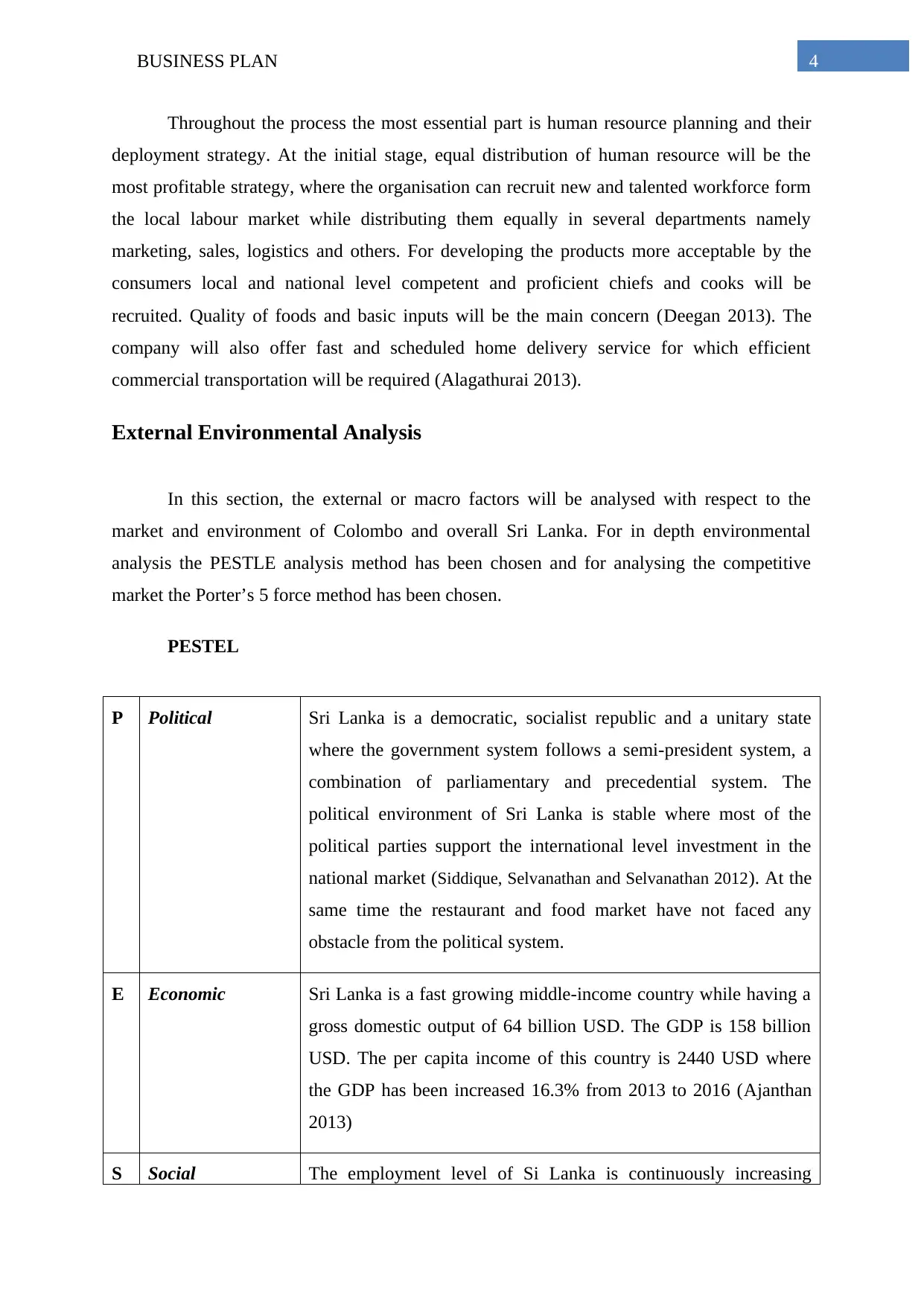
4BUSINESS PLAN
Throughout the process the most essential part is human resource planning and their
deployment strategy. At the initial stage, equal distribution of human resource will be the
most profitable strategy, where the organisation can recruit new and talented workforce form
the local labour market while distributing them equally in several departments namely
marketing, sales, logistics and others. For developing the products more acceptable by the
consumers local and national level competent and proficient chiefs and cooks will be
recruited. Quality of foods and basic inputs will be the main concern (Deegan 2013). The
company will also offer fast and scheduled home delivery service for which efficient
commercial transportation will be required (Alagathurai 2013).
External Environmental Analysis
In this section, the external or macro factors will be analysed with respect to the
market and environment of Colombo and overall Sri Lanka. For in depth environmental
analysis the PESTLE analysis method has been chosen and for analysing the competitive
market the Porter’s 5 force method has been chosen.
PESTEL
P Political Sri Lanka is a democratic, socialist republic and a unitary state
where the government system follows a semi-president system, a
combination of parliamentary and precedential system. The
political environment of Sri Lanka is stable where most of the
political parties support the international level investment in the
national market (Siddique, Selvanathan and Selvanathan 2012). At the
same time the restaurant and food market have not faced any
obstacle from the political system.
E Economic Sri Lanka is a fast growing middle-income country while having a
gross domestic output of 64 billion USD. The GDP is 158 billion
USD. The per capita income of this country is 2440 USD where
the GDP has been increased 16.3% from 2013 to 2016 (Ajanthan
2013)
S Social The employment level of Si Lanka is continuously increasing
Throughout the process the most essential part is human resource planning and their
deployment strategy. At the initial stage, equal distribution of human resource will be the
most profitable strategy, where the organisation can recruit new and talented workforce form
the local labour market while distributing them equally in several departments namely
marketing, sales, logistics and others. For developing the products more acceptable by the
consumers local and national level competent and proficient chiefs and cooks will be
recruited. Quality of foods and basic inputs will be the main concern (Deegan 2013). The
company will also offer fast and scheduled home delivery service for which efficient
commercial transportation will be required (Alagathurai 2013).
External Environmental Analysis
In this section, the external or macro factors will be analysed with respect to the
market and environment of Colombo and overall Sri Lanka. For in depth environmental
analysis the PESTLE analysis method has been chosen and for analysing the competitive
market the Porter’s 5 force method has been chosen.
PESTEL
P Political Sri Lanka is a democratic, socialist republic and a unitary state
where the government system follows a semi-president system, a
combination of parliamentary and precedential system. The
political environment of Sri Lanka is stable where most of the
political parties support the international level investment in the
national market (Siddique, Selvanathan and Selvanathan 2012). At the
same time the restaurant and food market have not faced any
obstacle from the political system.
E Economic Sri Lanka is a fast growing middle-income country while having a
gross domestic output of 64 billion USD. The GDP is 158 billion
USD. The per capita income of this country is 2440 USD where
the GDP has been increased 16.3% from 2013 to 2016 (Ajanthan
2013)
S Social The employment level of Si Lanka is continuously increasing
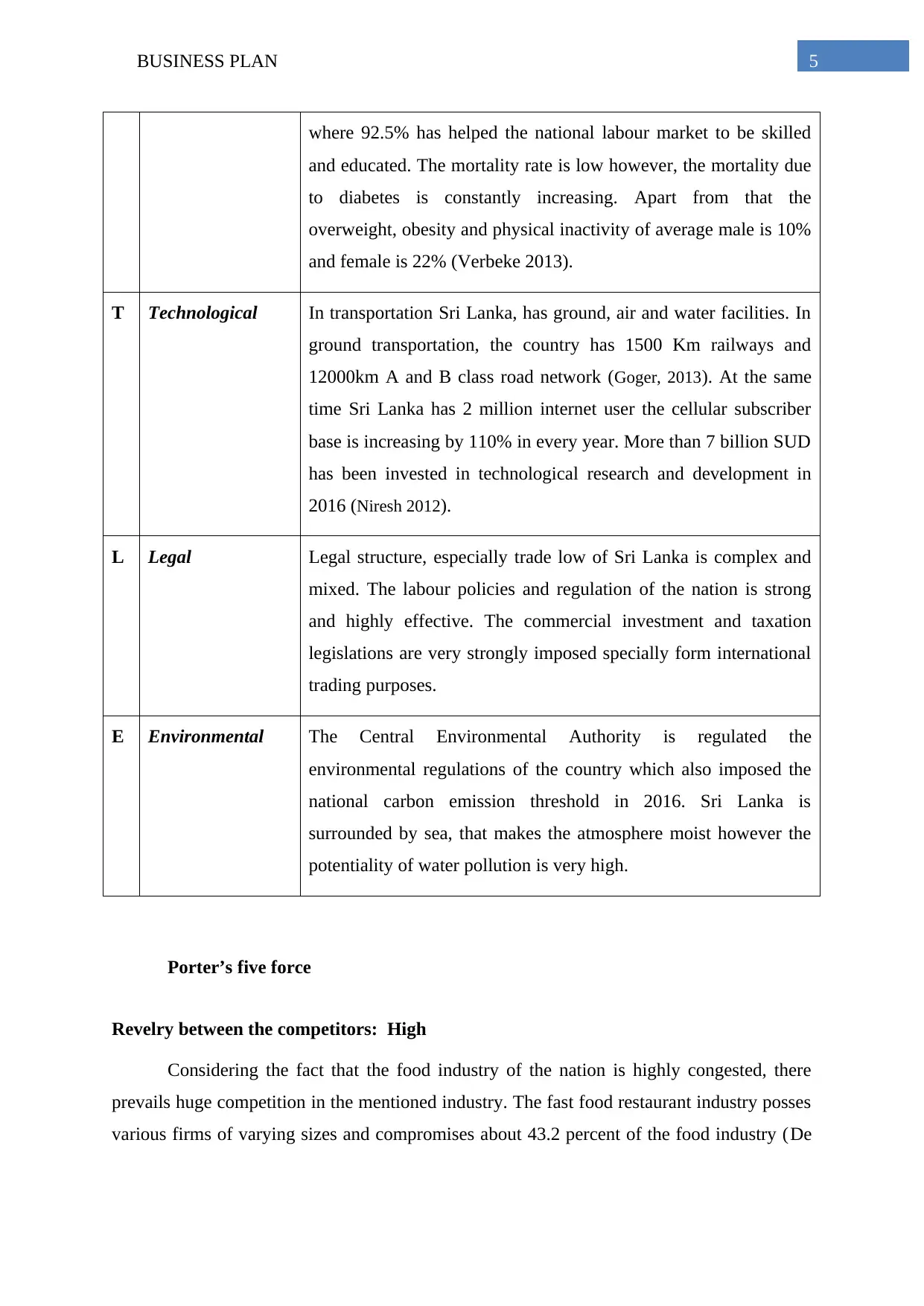
5BUSINESS PLAN
where 92.5% has helped the national labour market to be skilled
and educated. The mortality rate is low however, the mortality due
to diabetes is constantly increasing. Apart from that the
overweight, obesity and physical inactivity of average male is 10%
and female is 22% (Verbeke 2013).
T Technological In transportation Sri Lanka, has ground, air and water facilities. In
ground transportation, the country has 1500 Km railways and
12000km A and B class road network (Goger, 2013). At the same
time Sri Lanka has 2 million internet user the cellular subscriber
base is increasing by 110% in every year. More than 7 billion SUD
has been invested in technological research and development in
2016 (Niresh 2012).
L Legal Legal structure, especially trade low of Sri Lanka is complex and
mixed. The labour policies and regulation of the nation is strong
and highly effective. The commercial investment and taxation
legislations are very strongly imposed specially form international
trading purposes.
E Environmental The Central Environmental Authority is regulated the
environmental regulations of the country which also imposed the
national carbon emission threshold in 2016. Sri Lanka is
surrounded by sea, that makes the atmosphere moist however the
potentiality of water pollution is very high.
Porter’s five force
Revelry between the competitors: High
Considering the fact that the food industry of the nation is highly congested, there
prevails huge competition in the mentioned industry. The fast food restaurant industry posses
various firms of varying sizes and compromises about 43.2 percent of the food industry (De
where 92.5% has helped the national labour market to be skilled
and educated. The mortality rate is low however, the mortality due
to diabetes is constantly increasing. Apart from that the
overweight, obesity and physical inactivity of average male is 10%
and female is 22% (Verbeke 2013).
T Technological In transportation Sri Lanka, has ground, air and water facilities. In
ground transportation, the country has 1500 Km railways and
12000km A and B class road network (Goger, 2013). At the same
time Sri Lanka has 2 million internet user the cellular subscriber
base is increasing by 110% in every year. More than 7 billion SUD
has been invested in technological research and development in
2016 (Niresh 2012).
L Legal Legal structure, especially trade low of Sri Lanka is complex and
mixed. The labour policies and regulation of the nation is strong
and highly effective. The commercial investment and taxation
legislations are very strongly imposed specially form international
trading purposes.
E Environmental The Central Environmental Authority is regulated the
environmental regulations of the country which also imposed the
national carbon emission threshold in 2016. Sri Lanka is
surrounded by sea, that makes the atmosphere moist however the
potentiality of water pollution is very high.
Porter’s five force
Revelry between the competitors: High
Considering the fact that the food industry of the nation is highly congested, there
prevails huge competition in the mentioned industry. The fast food restaurant industry posses
various firms of varying sizes and compromises about 43.2 percent of the food industry (De
⊘ This is a preview!⊘
Do you want full access?
Subscribe today to unlock all pages.

Trusted by 1+ million students worldwide
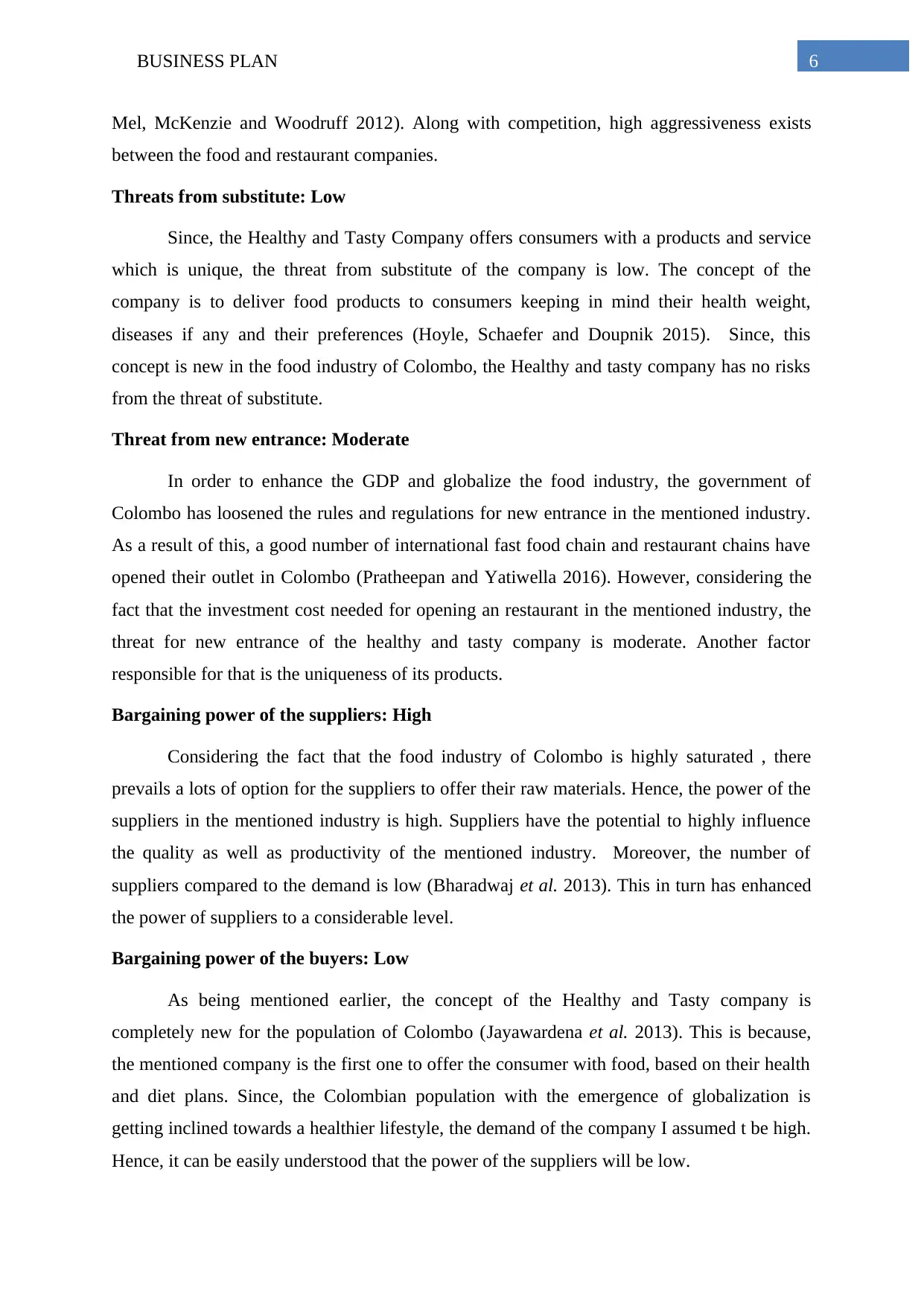
6BUSINESS PLAN
Mel, McKenzie and Woodruff 2012). Along with competition, high aggressiveness exists
between the food and restaurant companies.
Threats from substitute: Low
Since, the Healthy and Tasty Company offers consumers with a products and service
which is unique, the threat from substitute of the company is low. The concept of the
company is to deliver food products to consumers keeping in mind their health weight,
diseases if any and their preferences (Hoyle, Schaefer and Doupnik 2015). Since, this
concept is new in the food industry of Colombo, the Healthy and tasty company has no risks
from the threat of substitute.
Threat from new entrance: Moderate
In order to enhance the GDP and globalize the food industry, the government of
Colombo has loosened the rules and regulations for new entrance in the mentioned industry.
As a result of this, a good number of international fast food chain and restaurant chains have
opened their outlet in Colombo (Pratheepan and Yatiwella 2016). However, considering the
fact that the investment cost needed for opening an restaurant in the mentioned industry, the
threat for new entrance of the healthy and tasty company is moderate. Another factor
responsible for that is the uniqueness of its products.
Bargaining power of the suppliers: High
Considering the fact that the food industry of Colombo is highly saturated , there
prevails a lots of option for the suppliers to offer their raw materials. Hence, the power of the
suppliers in the mentioned industry is high. Suppliers have the potential to highly influence
the quality as well as productivity of the mentioned industry. Moreover, the number of
suppliers compared to the demand is low (Bharadwaj et al. 2013). This in turn has enhanced
the power of suppliers to a considerable level.
Bargaining power of the buyers: Low
As being mentioned earlier, the concept of the Healthy and Tasty company is
completely new for the population of Colombo (Jayawardena et al. 2013). This is because,
the mentioned company is the first one to offer the consumer with food, based on their health
and diet plans. Since, the Colombian population with the emergence of globalization is
getting inclined towards a healthier lifestyle, the demand of the company I assumed t be high.
Hence, it can be easily understood that the power of the suppliers will be low.
Mel, McKenzie and Woodruff 2012). Along with competition, high aggressiveness exists
between the food and restaurant companies.
Threats from substitute: Low
Since, the Healthy and Tasty Company offers consumers with a products and service
which is unique, the threat from substitute of the company is low. The concept of the
company is to deliver food products to consumers keeping in mind their health weight,
diseases if any and their preferences (Hoyle, Schaefer and Doupnik 2015). Since, this
concept is new in the food industry of Colombo, the Healthy and tasty company has no risks
from the threat of substitute.
Threat from new entrance: Moderate
In order to enhance the GDP and globalize the food industry, the government of
Colombo has loosened the rules and regulations for new entrance in the mentioned industry.
As a result of this, a good number of international fast food chain and restaurant chains have
opened their outlet in Colombo (Pratheepan and Yatiwella 2016). However, considering the
fact that the investment cost needed for opening an restaurant in the mentioned industry, the
threat for new entrance of the healthy and tasty company is moderate. Another factor
responsible for that is the uniqueness of its products.
Bargaining power of the suppliers: High
Considering the fact that the food industry of Colombo is highly saturated , there
prevails a lots of option for the suppliers to offer their raw materials. Hence, the power of the
suppliers in the mentioned industry is high. Suppliers have the potential to highly influence
the quality as well as productivity of the mentioned industry. Moreover, the number of
suppliers compared to the demand is low (Bharadwaj et al. 2013). This in turn has enhanced
the power of suppliers to a considerable level.
Bargaining power of the buyers: Low
As being mentioned earlier, the concept of the Healthy and Tasty company is
completely new for the population of Colombo (Jayawardena et al. 2013). This is because,
the mentioned company is the first one to offer the consumer with food, based on their health
and diet plans. Since, the Colombian population with the emergence of globalization is
getting inclined towards a healthier lifestyle, the demand of the company I assumed t be high.
Hence, it can be easily understood that the power of the suppliers will be low.
Paraphrase This Document
Need a fresh take? Get an instant paraphrase of this document with our AI Paraphraser
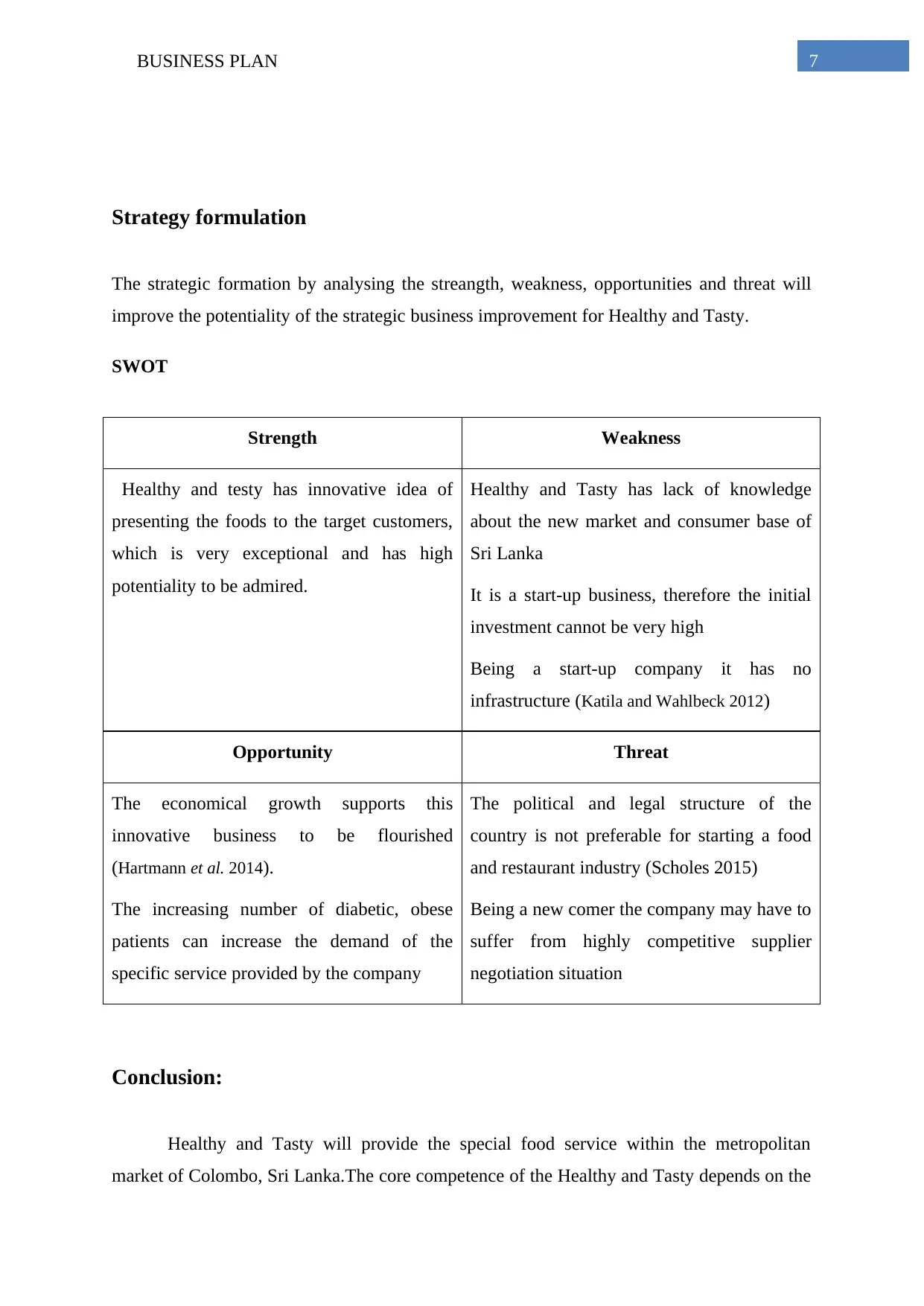
7BUSINESS PLAN
Strategy formulation
The strategic formation by analysing the streangth, weakness, opportunities and threat will
improve the potentiality of the strategic business improvement for Healthy and Tasty.
SWOT
Strength Weakness
Healthy and testy has innovative idea of
presenting the foods to the target customers,
which is very exceptional and has high
potentiality to be admired.
Healthy and Tasty has lack of knowledge
about the new market and consumer base of
Sri Lanka
It is a start-up business, therefore the initial
investment cannot be very high
Being a start-up company it has no
infrastructure (Katila and Wahlbeck 2012)
Opportunity Threat
The economical growth supports this
innovative business to be flourished
(Hartmann et al. 2014).
The increasing number of diabetic, obese
patients can increase the demand of the
specific service provided by the company
The political and legal structure of the
country is not preferable for starting a food
and restaurant industry (Scholes 2015)
Being a new comer the company may have to
suffer from highly competitive supplier
negotiation situation
Conclusion:
Healthy and Tasty will provide the special food service within the metropolitan
market of Colombo, Sri Lanka.The core competence of the Healthy and Tasty depends on the
Strategy formulation
The strategic formation by analysing the streangth, weakness, opportunities and threat will
improve the potentiality of the strategic business improvement for Healthy and Tasty.
SWOT
Strength Weakness
Healthy and testy has innovative idea of
presenting the foods to the target customers,
which is very exceptional and has high
potentiality to be admired.
Healthy and Tasty has lack of knowledge
about the new market and consumer base of
Sri Lanka
It is a start-up business, therefore the initial
investment cannot be very high
Being a start-up company it has no
infrastructure (Katila and Wahlbeck 2012)
Opportunity Threat
The economical growth supports this
innovative business to be flourished
(Hartmann et al. 2014).
The increasing number of diabetic, obese
patients can increase the demand of the
specific service provided by the company
The political and legal structure of the
country is not preferable for starting a food
and restaurant industry (Scholes 2015)
Being a new comer the company may have to
suffer from highly competitive supplier
negotiation situation
Conclusion:
Healthy and Tasty will provide the special food service within the metropolitan
market of Colombo, Sri Lanka.The core competence of the Healthy and Tasty depends on the
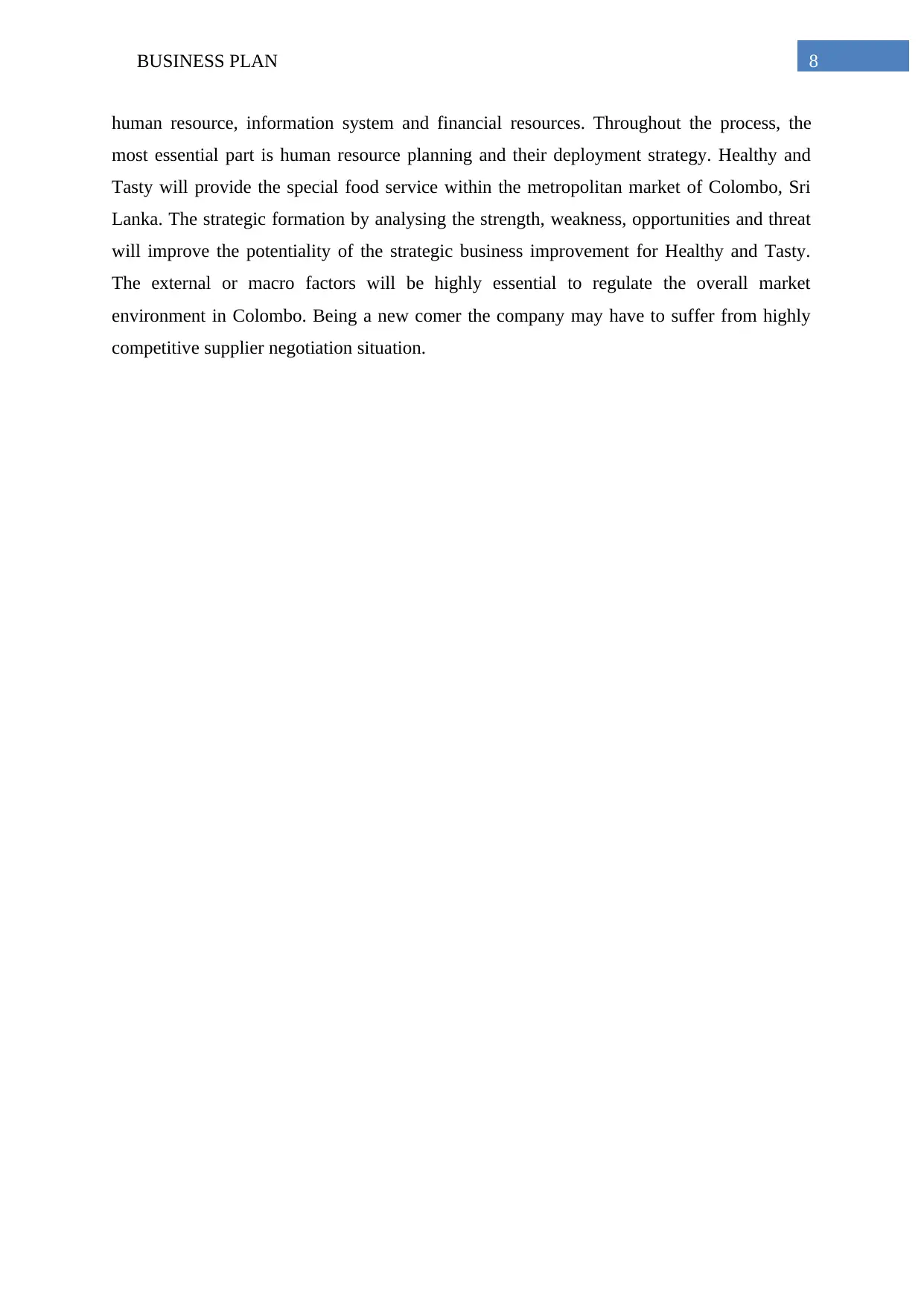
8BUSINESS PLAN
human resource, information system and financial resources. Throughout the process, the
most essential part is human resource planning and their deployment strategy. Healthy and
Tasty will provide the special food service within the metropolitan market of Colombo, Sri
Lanka. The strategic formation by analysing the strength, weakness, opportunities and threat
will improve the potentiality of the strategic business improvement for Healthy and Tasty.
The external or macro factors will be highly essential to regulate the overall market
environment in Colombo. Being a new comer the company may have to suffer from highly
competitive supplier negotiation situation.
human resource, information system and financial resources. Throughout the process, the
most essential part is human resource planning and their deployment strategy. Healthy and
Tasty will provide the special food service within the metropolitan market of Colombo, Sri
Lanka. The strategic formation by analysing the strength, weakness, opportunities and threat
will improve the potentiality of the strategic business improvement for Healthy and Tasty.
The external or macro factors will be highly essential to regulate the overall market
environment in Colombo. Being a new comer the company may have to suffer from highly
competitive supplier negotiation situation.
⊘ This is a preview!⊘
Do you want full access?
Subscribe today to unlock all pages.

Trusted by 1+ million students worldwide
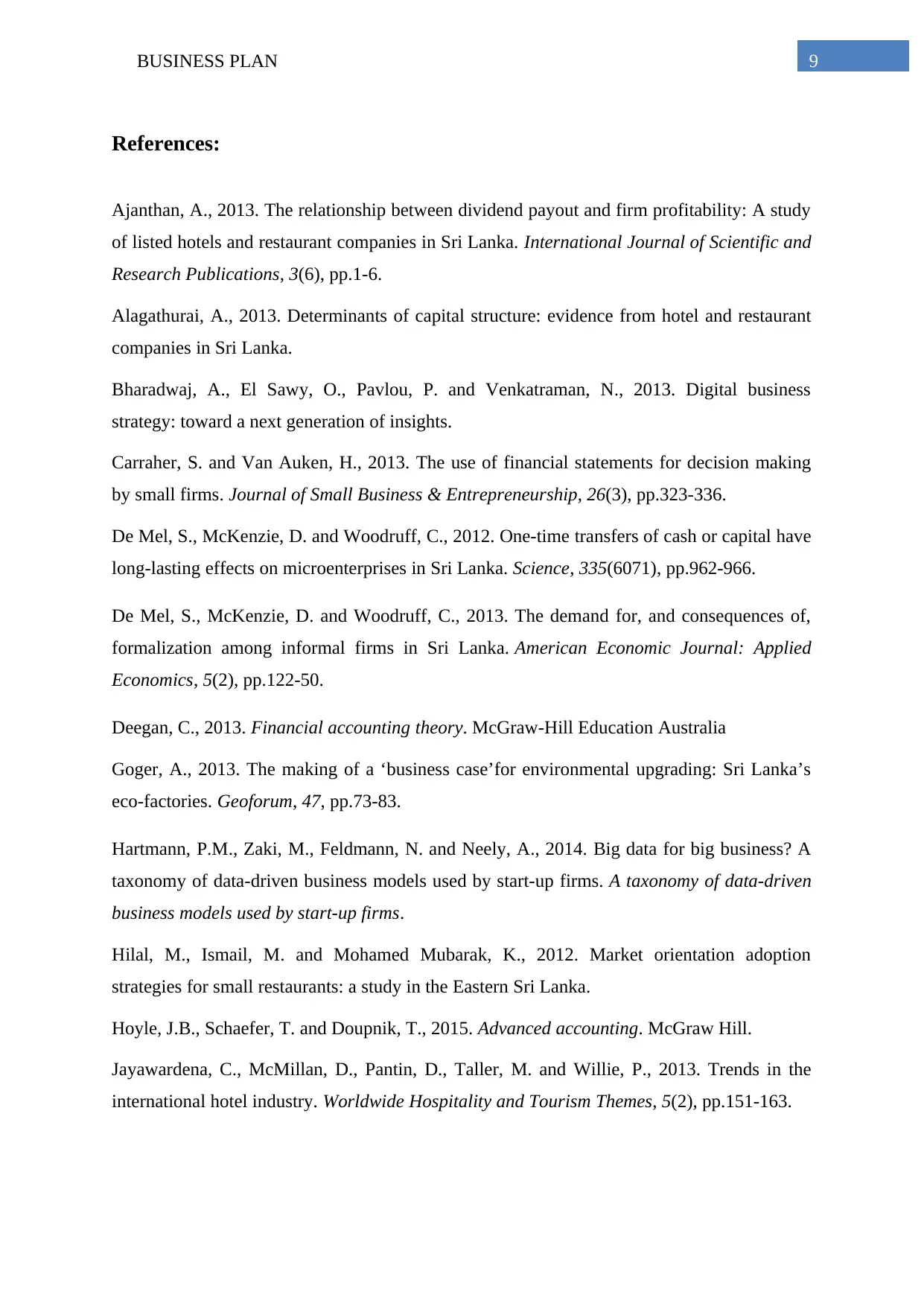
9BUSINESS PLAN
References:
Ajanthan, A., 2013. The relationship between dividend payout and firm profitability: A study
of listed hotels and restaurant companies in Sri Lanka. International Journal of Scientific and
Research Publications, 3(6), pp.1-6.
Alagathurai, A., 2013. Determinants of capital structure: evidence from hotel and restaurant
companies in Sri Lanka.
Bharadwaj, A., El Sawy, O., Pavlou, P. and Venkatraman, N., 2013. Digital business
strategy: toward a next generation of insights.
Carraher, S. and Van Auken, H., 2013. The use of financial statements for decision making
by small firms. Journal of Small Business & Entrepreneurship, 26(3), pp.323-336.
De Mel, S., McKenzie, D. and Woodruff, C., 2012. One-time transfers of cash or capital have
long-lasting effects on microenterprises in Sri Lanka. Science, 335(6071), pp.962-966.
De Mel, S., McKenzie, D. and Woodruff, C., 2013. The demand for, and consequences of,
formalization among informal firms in Sri Lanka. American Economic Journal: Applied
Economics, 5(2), pp.122-50.
Deegan, C., 2013. Financial accounting theory. McGraw-Hill Education Australia
Goger, A., 2013. The making of a ‘business case’for environmental upgrading: Sri Lanka’s
eco-factories. Geoforum, 47, pp.73-83.
Hartmann, P.M., Zaki, M., Feldmann, N. and Neely, A., 2014. Big data for big business? A
taxonomy of data-driven business models used by start-up firms. A taxonomy of data-driven
business models used by start-up firms.
Hilal, M., Ismail, M. and Mohamed Mubarak, K., 2012. Market orientation adoption
strategies for small restaurants: a study in the Eastern Sri Lanka.
Hoyle, J.B., Schaefer, T. and Doupnik, T., 2015. Advanced accounting. McGraw Hill.
Jayawardena, C., McMillan, D., Pantin, D., Taller, M. and Willie, P., 2013. Trends in the
international hotel industry. Worldwide Hospitality and Tourism Themes, 5(2), pp.151-163.
References:
Ajanthan, A., 2013. The relationship between dividend payout and firm profitability: A study
of listed hotels and restaurant companies in Sri Lanka. International Journal of Scientific and
Research Publications, 3(6), pp.1-6.
Alagathurai, A., 2013. Determinants of capital structure: evidence from hotel and restaurant
companies in Sri Lanka.
Bharadwaj, A., El Sawy, O., Pavlou, P. and Venkatraman, N., 2013. Digital business
strategy: toward a next generation of insights.
Carraher, S. and Van Auken, H., 2013. The use of financial statements for decision making
by small firms. Journal of Small Business & Entrepreneurship, 26(3), pp.323-336.
De Mel, S., McKenzie, D. and Woodruff, C., 2012. One-time transfers of cash or capital have
long-lasting effects on microenterprises in Sri Lanka. Science, 335(6071), pp.962-966.
De Mel, S., McKenzie, D. and Woodruff, C., 2013. The demand for, and consequences of,
formalization among informal firms in Sri Lanka. American Economic Journal: Applied
Economics, 5(2), pp.122-50.
Deegan, C., 2013. Financial accounting theory. McGraw-Hill Education Australia
Goger, A., 2013. The making of a ‘business case’for environmental upgrading: Sri Lanka’s
eco-factories. Geoforum, 47, pp.73-83.
Hartmann, P.M., Zaki, M., Feldmann, N. and Neely, A., 2014. Big data for big business? A
taxonomy of data-driven business models used by start-up firms. A taxonomy of data-driven
business models used by start-up firms.
Hilal, M., Ismail, M. and Mohamed Mubarak, K., 2012. Market orientation adoption
strategies for small restaurants: a study in the Eastern Sri Lanka.
Hoyle, J.B., Schaefer, T. and Doupnik, T., 2015. Advanced accounting. McGraw Hill.
Jayawardena, C., McMillan, D., Pantin, D., Taller, M. and Willie, P., 2013. Trends in the
international hotel industry. Worldwide Hospitality and Tourism Themes, 5(2), pp.151-163.
Paraphrase This Document
Need a fresh take? Get an instant paraphrase of this document with our AI Paraphraser
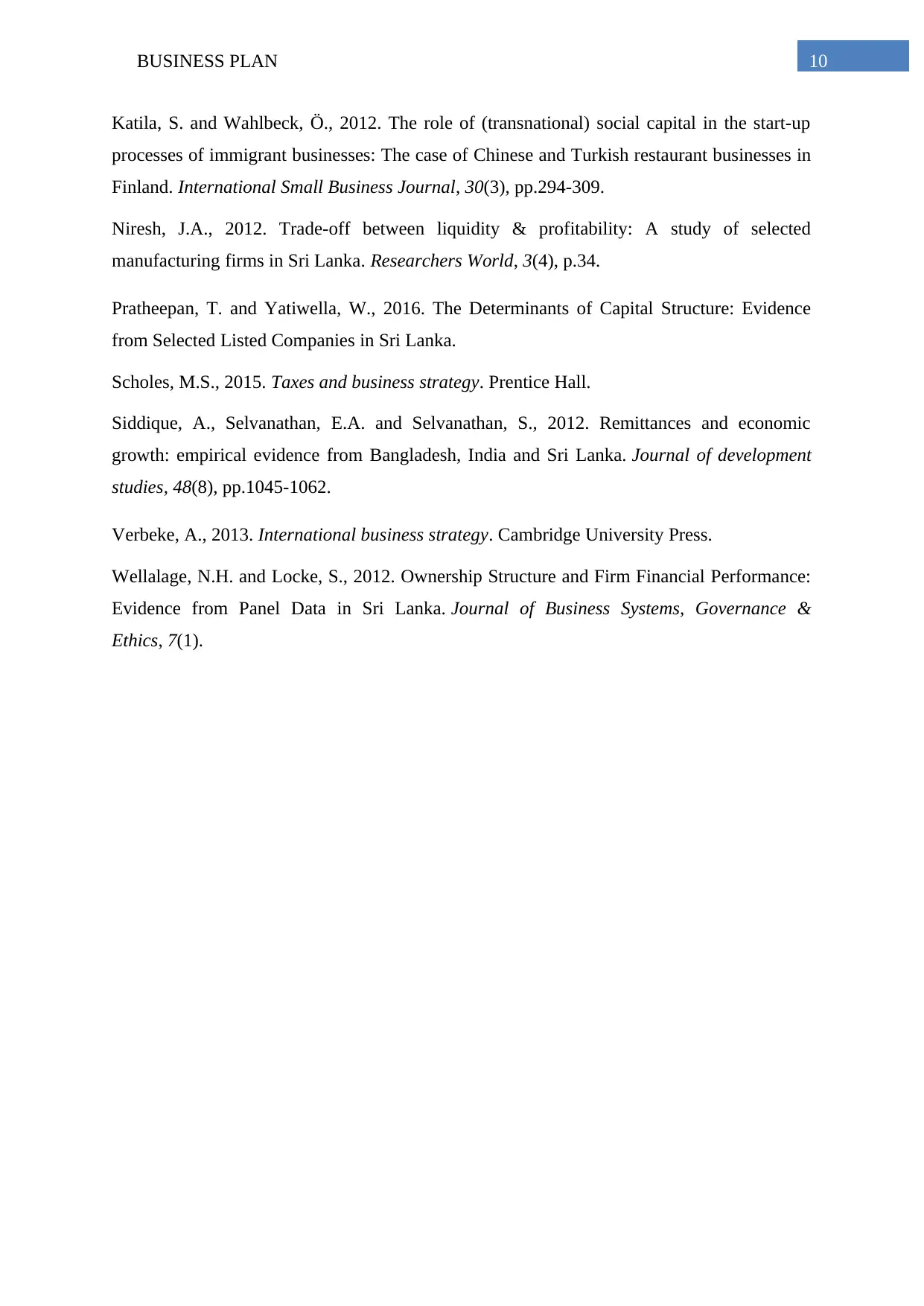
10BUSINESS PLAN
Katila, S. and Wahlbeck, Ö., 2012. The role of (transnational) social capital in the start-up
processes of immigrant businesses: The case of Chinese and Turkish restaurant businesses in
Finland. International Small Business Journal, 30(3), pp.294-309.
Niresh, J.A., 2012. Trade-off between liquidity & profitability: A study of selected
manufacturing firms in Sri Lanka. Researchers World, 3(4), p.34.
Pratheepan, T. and Yatiwella, W., 2016. The Determinants of Capital Structure: Evidence
from Selected Listed Companies in Sri Lanka.
Scholes, M.S., 2015. Taxes and business strategy. Prentice Hall.
Siddique, A., Selvanathan, E.A. and Selvanathan, S., 2012. Remittances and economic
growth: empirical evidence from Bangladesh, India and Sri Lanka. Journal of development
studies, 48(8), pp.1045-1062.
Verbeke, A., 2013. International business strategy. Cambridge University Press.
Wellalage, N.H. and Locke, S., 2012. Ownership Structure and Firm Financial Performance:
Evidence from Panel Data in Sri Lanka. Journal of Business Systems, Governance &
Ethics, 7(1).
Katila, S. and Wahlbeck, Ö., 2012. The role of (transnational) social capital in the start-up
processes of immigrant businesses: The case of Chinese and Turkish restaurant businesses in
Finland. International Small Business Journal, 30(3), pp.294-309.
Niresh, J.A., 2012. Trade-off between liquidity & profitability: A study of selected
manufacturing firms in Sri Lanka. Researchers World, 3(4), p.34.
Pratheepan, T. and Yatiwella, W., 2016. The Determinants of Capital Structure: Evidence
from Selected Listed Companies in Sri Lanka.
Scholes, M.S., 2015. Taxes and business strategy. Prentice Hall.
Siddique, A., Selvanathan, E.A. and Selvanathan, S., 2012. Remittances and economic
growth: empirical evidence from Bangladesh, India and Sri Lanka. Journal of development
studies, 48(8), pp.1045-1062.
Verbeke, A., 2013. International business strategy. Cambridge University Press.
Wellalage, N.H. and Locke, S., 2012. Ownership Structure and Firm Financial Performance:
Evidence from Panel Data in Sri Lanka. Journal of Business Systems, Governance &
Ethics, 7(1).
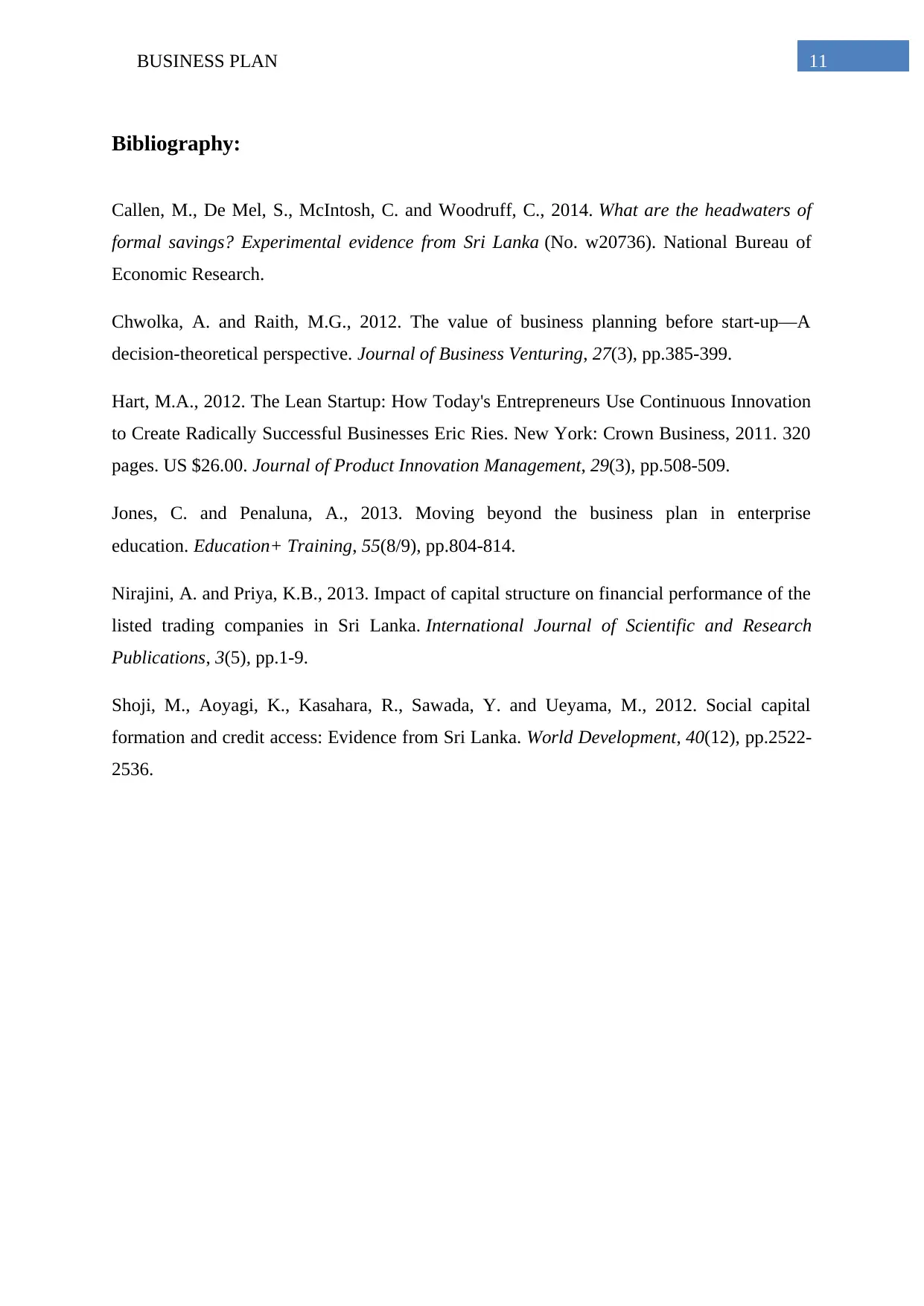
11BUSINESS PLAN
Bibliography:
Callen, M., De Mel, S., McIntosh, C. and Woodruff, C., 2014. What are the headwaters of
formal savings? Experimental evidence from Sri Lanka (No. w20736). National Bureau of
Economic Research.
Chwolka, A. and Raith, M.G., 2012. The value of business planning before start-up—A
decision-theoretical perspective. Journal of Business Venturing, 27(3), pp.385-399.
Hart, M.A., 2012. The Lean Startup: How Today's Entrepreneurs Use Continuous Innovation
to Create Radically Successful Businesses Eric Ries. New York: Crown Business, 2011. 320
pages. US $26.00. Journal of Product Innovation Management, 29(3), pp.508-509.
Jones, C. and Penaluna, A., 2013. Moving beyond the business plan in enterprise
education. Education+ Training, 55(8/9), pp.804-814.
Nirajini, A. and Priya, K.B., 2013. Impact of capital structure on financial performance of the
listed trading companies in Sri Lanka. International Journal of Scientific and Research
Publications, 3(5), pp.1-9.
Shoji, M., Aoyagi, K., Kasahara, R., Sawada, Y. and Ueyama, M., 2012. Social capital
formation and credit access: Evidence from Sri Lanka. World Development, 40(12), pp.2522-
2536.
Bibliography:
Callen, M., De Mel, S., McIntosh, C. and Woodruff, C., 2014. What are the headwaters of
formal savings? Experimental evidence from Sri Lanka (No. w20736). National Bureau of
Economic Research.
Chwolka, A. and Raith, M.G., 2012. The value of business planning before start-up—A
decision-theoretical perspective. Journal of Business Venturing, 27(3), pp.385-399.
Hart, M.A., 2012. The Lean Startup: How Today's Entrepreneurs Use Continuous Innovation
to Create Radically Successful Businesses Eric Ries. New York: Crown Business, 2011. 320
pages. US $26.00. Journal of Product Innovation Management, 29(3), pp.508-509.
Jones, C. and Penaluna, A., 2013. Moving beyond the business plan in enterprise
education. Education+ Training, 55(8/9), pp.804-814.
Nirajini, A. and Priya, K.B., 2013. Impact of capital structure on financial performance of the
listed trading companies in Sri Lanka. International Journal of Scientific and Research
Publications, 3(5), pp.1-9.
Shoji, M., Aoyagi, K., Kasahara, R., Sawada, Y. and Ueyama, M., 2012. Social capital
formation and credit access: Evidence from Sri Lanka. World Development, 40(12), pp.2522-
2536.
⊘ This is a preview!⊘
Do you want full access?
Subscribe today to unlock all pages.

Trusted by 1+ million students worldwide
1 out of 13
Related Documents
Your All-in-One AI-Powered Toolkit for Academic Success.
+13062052269
info@desklib.com
Available 24*7 on WhatsApp / Email
![[object Object]](/_next/static/media/star-bottom.7253800d.svg)
Unlock your academic potential
Copyright © 2020–2025 A2Z Services. All Rights Reserved. Developed and managed by ZUCOL.





